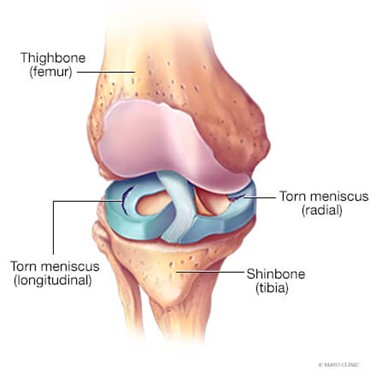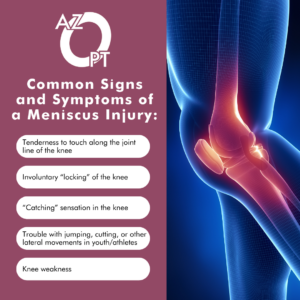Healing After a Meniscus Injury
by Jeff Landram PT, DPT, Cert. DN
AzOPT Buckeye Physical Therapist
More than a decade ago, long before my days as a physical therapist, I tore the meniscus in my knee playing football a little too rough on Thanksgiving. Immediately afterward, my knee would lock in a way that would send shivers down my spine. I couldn’t walk, and my knee was the size of a grapefruit. Unfortunately, it was severe enough to require surgery.
However, not all meniscus injuries require surgery to return you to a healthy, pain-free lifestyle. A licensed physical therapist may be able to help overcome that nagging knee pain without the invasive surgery.
 The meniscus is underlying cartilage in the knee that helps to cushion the space between the two knee bones; the femur and tibia. This cushioning can become frayed or torn after a traumatic injury or even slowly with age, and this fraying can cause quite a bit of pain in the knee. This pain can then lead to apprehension with walking, weakness in the leg, or trouble bending/straightening the knee.
The meniscus is underlying cartilage in the knee that helps to cushion the space between the two knee bones; the femur and tibia. This cushioning can become frayed or torn after a traumatic injury or even slowly with age, and this fraying can cause quite a bit of pain in the knee. This pain can then lead to apprehension with walking, weakness in the leg, or trouble bending/straightening the knee.
Common signs and symptoms of a meniscus injury:
- Tenderness to touch along the joint line of the knee
- Involuntary “locking” of the knee
- “Catching” sensation in the knee
- Trouble with jumping, cutting, or other lateral movements in youth/athletes
- Knee weakness
Meniscus injuries are different from other structural injuries such as tendon or ligaments. Tendons are the connective tissue that bridges the gap between muscle and bone. A common example of a tendon injury would be an Achilles tear in the ankle. Ligaments are what secure two bony surfaces to one another. ACL tears in athletes are a common ligamentous injury. These tendon or ligamentous injuries directly affect an individual’s ability to use their muscles or stability of the joint of which the tissues are associated.
The primary function of the meniscus is to provide cushion and comfort; not stability or strength. While an injury to the meniscus is not ideal, it does not always require immediate surgical intervention.
A physical therapy plan of care for a meniscus injury will be tailored specific to the patient’s needs and limitations. Some typical areas of focus would be:
- Restoring full range of motion in the knee
- Returning to a normal gait pattern without compensation
- Lower body flexibility
- Strengthening the quadriceps and hamstring muscles
By focusing on these areas, we can significantly relieve knee pain and dysfunction by taking pressure off the injured knee with support from stronger and more flexible muscles. Additionally, your physical therapy plan will include a personalized home exercise program designed to maintain health independently at home.
If you have experienced a meniscus injury or fear that you may have suffered one, please contact your nearest AzOPT physical therapy clinic to schedule an evaluation. Conservative physical therapy treatment could give you significant relief of your pain for a fraction of the cost. Life is too short to be living in pain!








